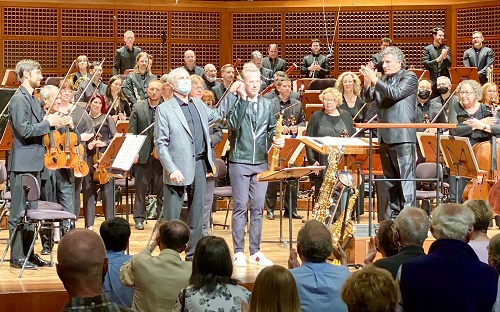 United States Various: Timothy McAllister (saxophones), Daniel Binelli (bandoneon), San Francisco Symphony / Giancarlo Guerrero (conductor). Davies Symphony Hall, San Francisco, 7.4.2022. (HS)
United States Various: Timothy McAllister (saxophones), Daniel Binelli (bandoneon), San Francisco Symphony / Giancarlo Guerrero (conductor). Davies Symphony Hall, San Francisco, 7.4.2022. (HS)

Adolphus Hailstork – An American Port of Call
John Corigliano – Saxophone Concerto (San Francisco Symphony Commission, world premiere)
Antonio Estévez – Mediodía en el Llano
Astor Piazzolla – Sinfonía Buenos Aires
John Corigliano’s Saxophone Concerto kicks off with what could have been a screech or a squawk from Timothy McAllister’s soprano sax, a leap of more than an octave to the instrument’s highest register. McAllister, a master of the instrument, made it into a melodious call to action. Throughout the concerto (which in its 30 minutes makes technical and interpretive demands on McAllister on alto and baritone saxophones as well), the soloist made everything feel natural in the piece’s world première on Thursday afternoon.
It is a formidable challenge for a saxophonist to make the composer’s astonishing range of sounds flow as smoothly and enticingly as McAllister does, nor is it a given that the intricate rhythmic give-and-take between soloist and conductor Giancarlo Guerrero could fall into place as merrily as it did with the San Francisco Symphony at Davies Symphony Hall. The results, however, were nothing short of exhilarating.
The concerto highlighted a program that traded in big orchestral forces by composers such as Astor Piazzolla, Antonio Estévez and Adolphus Hailstork
Pandemic cancellations forced McAllister, whose work with the PRISM Quartet and many solo appearances have included more than 300 new works (and a concerto by John Adams), to reschedule this debut, originally set for the spring of 2020. It was worth the wait, and the composer, 84, was in attendance to hear it come to life.
Corigliano still produces music that glows with harmonic and melodic invention and richness: the debut of his opera The Lord of Cries highlighted the Santa Fe Opera season last summer. This is his ninth concerto, and it makes a strong case as his best – at least on a par with his concerto written for Joshua Bell, The Red Violin.
The sax’s melodic leap at the start sparks a celebratory whooping throughout the orchestra, as the ensemble and soloist outdo each other with how effortlessly they can execute music that jumps from midrange to high and back to the lowest registers. The brass underline the skips with a rat-a-tat of staccato interruption on a single note, and the whole orchestra engages in rapid rhythmic back-and-forths with the soloist to finish each other’s phrases.
As the first movement explores the possibilities, Corigliano makes all this feel utterly spontaneous. He is a master at orchestration and musical architecture and not without humor. Toward the end of the first movement the trombones respond to a saxophone flourish with sassy glissando taunting that made me laugh out loud.
In contrast, the second movement, played on alto sax, is all lyrical sweetness and calm. The orchestra sometimes rests on a single note or a smoothly voiced chord, as McAllister channels his inner Paul Desmond for beautiful tone. At times, as the orchestra carries a gentle melody, the saxophone flutters with quiet rippling phrases. These are haunting moments.
The baritone sax starts the finale by clicking the instrument’s keys and slap-tonguing to create a punchy, jaunty, staccato dance. As the orchestra picks up the rhythm, the saxophone counters with legato countermelodies that climb from the very bottom to the very top of the instrument’s range. For a big finish, as the exuberance threatens to go over the top, McAllister switches back to soprano sax.
The thrills come partly from McAllister’s virtuosity but also from Corigliano’s fertile orchestral imagination. It is heady stuff, and I for one can’t wait to hear this again.
Although Astor Piazzolla’s Sinfonía Buenos Aires has been characterized as a bandoneon concerto, the soloist, Daniel Binelli, was positioned within the orchestra rather than out front. And for good reason: the occasional solo moment by Argentina’s all-button version of the accordion doesn’t amount to much. Instead, this early work by Argentina’s master of nuevo tango strikes a very different tone than his familiar tangos or later orchestral works such as The Four Seasons Porteñas, Maria de Buenos Aires and a real bandoneon concerto.
The work dates from the early 1950s, before the renowned French composition teacher Nadia Boulanger convinced Piazzolla to embrace his inner tango. This work, written when he was still studying composition with Alberto Ginastera, won a competition that sent him to Boulanger. It brims with Ginastera’s bold, loud, brassy imprint, and barely hints at the finesse and elegance of Piazzolla’s music after Boulanger. The textures are dense, and the tangos and bandoneon solos barely have the space to register.
Guerrero, who championed this work on a 2010 Grammy-winning recording on his regular gig as music director of the Nashville Symphony, led a full-throttle performance that brought the afternoon to a close with a big finish.
Two shorter works opened both halves of the program. Mediodía en el Llano by the Venezuelan composer Estévez, cast a spell of serenity and soulful harmonies over its nine minutes as a sort of prelude to the Piazzolla work. An American Port of Call raised a sort of dense ruckus. The tone poem from 1985 by the American composer Adolphus Hailstork describing a busy shipping port set the mood for an afternoon of big music.
Harvey Steiman
A fantastic review.